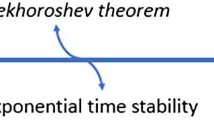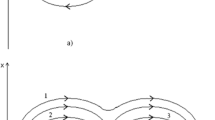Abstract
The Lidov–Kozai theory developed by each of the authors independently in 1961–1962 is based on qualitative methods of studying the evolution of orbits for the satellite version of the restricted three-body problem (Hill’s problem). At present, this theory is in demand in various fields of science: in the field of planetary research within the Solar system, the field of exoplanetary systems, and the field of high-energy physics in interstellar and intergalactic space. This has prompted me to popularize the ideas that underlie the Lidov–Kozai theory based on the experience of using this theory as an efficient tool for solving various problems related to the study of the secular evolution of the orbits of artificial planetary satellites under the influence of external gravitational perturbations with allowance made for the perturbations due to the polar planetary oblateness.
Similar content being viewed by others
References
V. I. Arnold, V. V. Kozlov, and A. I. Neishtadt, Mathematical Aspects of Classical and Celestial Mechanics, Encyclopaedia of Mathematical Sciences (Editorial URSS, Moscow, 2002; Springer, Berlin, 2006), p. 416.
C. Charlier, Celestial Mechanics (Veit, Leipzig, 1902; Fizmatlit,Moscow, 1966), rus. p. 627.
P. E. El’yasberg, Introduction to the Theory of Flight of Artificial Earth Satellites (Fizmatlit, Moscow, 1965; Israel Program for Scientific Translation, Jerusalem, 1967), rus. p. 540.
Yu. F. Gordeeva, Cosmic Res. 6, 450 (1968).
Y. Kozai, Astron. J. 67, 591 (1962).
M. L. Lidov, Iskusstv. Sputniki Zemli 8, 5 (1961).
M. L. Lidov, in Problems of the Motion of Artificial Celestial Bodies, Proceedings of the Conference on General and Applied Problems of Theoretical Astronomy, Moscow, Nov. 20–25, 1961 (Astron. Sovet AN SSSR, 1963), p. 119.
M. L. Lidov and M. V. Yarskaya, Cosmic Res. 12, 139 (1974)].
L. G. Luk’yanov and G. I. Shirmin, Lectures on Celestial Mechanics (Almaaty, 2009), p. 276 [in Russian].
A. S. Matvienko and V. V. Orlov, Astron. Lett. 41, 824 (2015)].
N. D. Moiseev, Tr. GAISh 15 (1), 100 (1945).
A. Morbidelli, Modern Celestial Mechanics: Dynamics in the Solar System, Advances in Astronomy and Astrophysics (Taylor and Francis, London, 2002; Moscow, Izhevsk, 2014, p. 413).
C. Murray and S. Dermott, Solar System Dynamics (Cambridge Univ. Press, Cambridge, 2000; Fizmatlit, Moscow, 2010, p. 588).
D. E. Okhotsimskii, T. M. Eneev, and G. P. Taratynova, Usp. Fiz. Nauk 63, 33 (1957).
V. I. Prokhorenko, Cosmic Res. 40, 264 (2002).
V. I. Prokhorenko, Izv. Vyssh. Uchebn. Zaved., Fiz., No. 2 Suppl., 63 (2006).
V. I. Prokhorenko, Tr.MIAN RAN 259, 156 (2007).
V. I. Prokhorenko, Cosmic Res. 48, 174 (2010).
V. I. Prokhorenko, Funct. Anal. Other Math. 3, 135 (2011). doi 10.1007.s11853-011-0046-y
V. I. Prokhorenko, Cosmic Res. 52, 125 (2014).
V. I. Prokhorenko, Cosmic Ballistics—from Origin to Future, Proceedings of the Seminar on Mechanics, Control and Informatics Dedicated to 100 Years from P.E. El’yasberg’s Birthday, June 17–19, 2014, Tarusa, Russia, Ed. by R. R. Nazirov (IKI RAN,Moscow, 2015), p. 130.
I. I. Shevchenko, The Lidov–Kozai Effect— Applications in Exoplanet Research and Dynamical Astronomy, Astrophys. Space Sci. Library (Springer, 2017), p. 194 [in Russian].
M. F. Subbotin, Course of Celestial Mechanics (ONTI, Moscow, Leningrad, 1937), Vol. 2 [in Russian].
M. F. Subbotin, Introduction to Theoretical Astronomy (Fizmatlit,Moscow, 1968), p. 800 [in Russian].
M. A. Vashkovyak, Astron. Lett. 22, 207 (1996).
M. A. Vashkovyak, Astron. Lett. 24, 682 (1998).
M. A. Vashkovyak, Astron. Lett. 25, 476 (1999).
Author information
Authors and Affiliations
Corresponding author
Additional information
Original Russian Text © V.I. Prokhorenko, 2018, published in Pis’ma v Astronomicheskii Zhurnal, 2018, Vol. 44, No. 1, pp. 52–70.
Rights and permissions
About this article
Cite this article
Prokhorenko, V.I. On the Dynamical Foundations of the Lidov–Kozai Theory. Astron. Lett. 44, 49–66 (2018). https://doi.org/10.1134/S1063773717120052
Received:
Published:
Issue Date:
DOI: https://doi.org/10.1134/S1063773717120052
Keywords
- Solar system dynamics
- restricted three-body problem
- orbital evolution of planetary satellites
- gravitational perturbations
- planetary oblateness
- qualitative studies
- first integrals
- integral curves in phase space
- secular evolution of orbits
- classification of manifolds of initial conditions
- boundaries of predominant influence of perturbing factors




